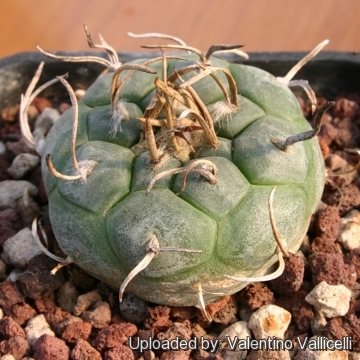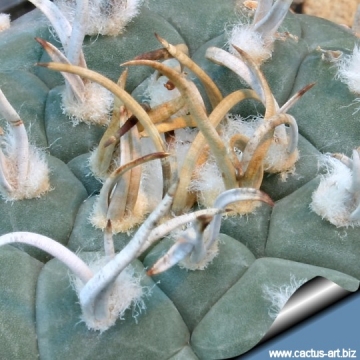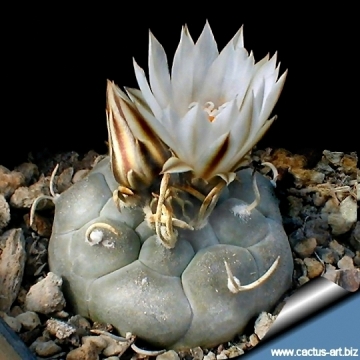
Turbinicarpus rioverdensis Photo by: Valentino Vallicelli
Origin and Habitat: Rio Verde in the state of San Lois Potosi (Mexico). Altitude 1500m.
Synonyms:
See all synonyms of Turbinicarpus rioverdensis
Description: Stem are usually solitary, depressed globular, 1,5 cm high 2,5-3,5 cm wide light green. With low rhomboidal and very flat tubercles.
Areoles: Yung areoles woolly, later bare.
Root: It has a swollen taproot.
Spines: 1-3 papery twisted cream/brown coloured, to 12 mm long. No central spine(s).
Flowers: White 25 mm long at the top of the stem, outside petals with greenish mid-stripes.
Subspecies, varieties, forms and cultivars of plants belonging to the Turbinicarpus schmiedickeanus group
 Turbinicarpus klinkerianus subs. hiemalis D.Donati & Zanov.: It flowers in winter, hence the scientific name "Hiemalis" (Belonging to winter)
Turbinicarpus klinkerianus subs. hiemalis D.Donati & Zanov.: It flowers in winter, hence the scientific name "Hiemalis" (Belonging to winter) Turbinicarpus macrochele subs. frailensis P.Lechner & Jantschgi: as fewer stigma lobes (3-6) white to yellowish-white, 2-3.5 mm long, straight, and only weakly papillose. Distribution: W to S-W of Matehuala, San Luis Potosi, México.
Turbinicarpus macrochele subs. frailensis P.Lechner & Jantschgi: as fewer stigma lobes (3-6) white to yellowish-white, 2-3.5 mm long, straight, and only weakly papillose. Distribution: W to S-W of Matehuala, San Luis Potosi, México.  Turbinicarpus macrochele subs. valteri D.Donati & Zanov.
Turbinicarpus macrochele subs. valteri D.Donati & Zanov. Turbinicarpus rioverdensis G.Frank: It comes from Rioverde, hence the scientific name "rioverdensis"
Turbinicarpus rioverdensis G.Frank: It comes from Rioverde, hence the scientific name "rioverdensis" Turbinicarpus rioverdensis subs. paoloi Halda & Kupčák: This is a form with long spines referable to T. schmiedickeanus ssp. schwarzii
Turbinicarpus rioverdensis subs. paoloi Halda & Kupčák: This is a form with long spines referable to T. schmiedickeanus ssp. schwarzii Turbinicarpus schmiedickeanus (Boed.) Buxb. & Backeb.: (ssp. schmiedickeanus) Stem disc-shaped, dull green and flat on top, twisted spines, and white to magenta flowers. Distribution: Miquihuana, Tamaulipas.
Turbinicarpus schmiedickeanus (Boed.) Buxb. & Backeb.: (ssp. schmiedickeanus) Stem disc-shaped, dull green and flat on top, twisted spines, and white to magenta flowers. Distribution: Miquihuana, Tamaulipas.- Turbinicarpus schmiedickeanus var. alenae Halda & Kupčák
 Turbinicarpus schmiedickeanus subs. andersonii Mosco & Zanov.: stem partly underground with pyramidal tubercles. Spines only 1-2. Flowers magenta and white in winter. Distribution: east of El Huizache, SLP, Mexico.
Turbinicarpus schmiedickeanus subs. andersonii Mosco & Zanov.: stem partly underground with pyramidal tubercles. Spines only 1-2. Flowers magenta and white in winter. Distribution: east of El Huizache, SLP, Mexico. Turbinicarpus schmiedickeanus f. aurata hort.: Mutant completely lacking chlorophyll pigment. The result is a completely cream-white, yellow or reddish plant.
Turbinicarpus schmiedickeanus f. aurata hort.: Mutant completely lacking chlorophyll pigment. The result is a completely cream-white, yellow or reddish plant. Turbinicarpus schmiedickeanus subs. bonatzii (G.Frank) Panar.: Dark green-bluish, semi-globose, depressed, divided into tubercles, merging in a tuberous root 3-5 cm long, and from it longer fibrous roots develop. It is closely related to Turbinicarpus schmiedickeanus ssp klinkerianus
Turbinicarpus schmiedickeanus subs. bonatzii (G.Frank) Panar.: Dark green-bluish, semi-globose, depressed, divided into tubercles, merging in a tuberous root 3-5 cm long, and from it longer fibrous roots develop. It is closely related to Turbinicarpus schmiedickeanus ssp klinkerianus Turbinicarpus schmiedickeanus f. cristatus hort.: crested form.
Turbinicarpus schmiedickeanus f. cristatus hort.: crested form. Turbinicarpus schmiedickeanus subs. dickisoniae (Glass & R.A.Foster) N.P.Taylor: It has gray-green stems. Radials spines: 18-24 finely acicular, rigid white young areoles (areole in old specimens have only central spines that curve slightly inward). No other variety of schmiedickeanus has as many radial spines nor as slender central spines. Distibution: Aramberri, Nuevo Leon.
Turbinicarpus schmiedickeanus subs. dickisoniae (Glass & R.A.Foster) N.P.Taylor: It has gray-green stems. Radials spines: 18-24 finely acicular, rigid white young areoles (areole in old specimens have only central spines that curve slightly inward). No other variety of schmiedickeanus has as many radial spines nor as slender central spines. Distibution: Aramberri, Nuevo Leon. Turbinicarpus schmiedickeanus subs. flaviflorus (G.Frank & A.B.Lau) Glass: It has a very distinctive form, described by some as almost pagoda-like with conical tubercles, 4(-6) spines and greenish yellow flowers. Distribution: Santa Rita, San Luis Potosi.
Turbinicarpus schmiedickeanus subs. flaviflorus (G.Frank & A.B.Lau) Glass: It has a very distinctive form, described by some as almost pagoda-like with conical tubercles, 4(-6) spines and greenish yellow flowers. Distribution: Santa Rita, San Luis Potosi. Turbinicarpus schmiedickeanus subs. flaviflorus f. brevispinus: it has very short corky brownish spines that contrast well with the body which is coated in a whitish bloom.
Turbinicarpus schmiedickeanus subs. flaviflorus f. brevispinus: it has very short corky brownish spines that contrast well with the body which is coated in a whitish bloom. Turbinicarpus schmiedickeanus subs. gracilis (Glass & R.A.Foster) Glass: Stem with nearly round, slender tubercles, one thin, slender papery central spine, and white flowers; Distribution: Aramberri, Nuevo Leon.
Turbinicarpus schmiedickeanus subs. gracilis (Glass & R.A.Foster) Glass: Stem with nearly round, slender tubercles, one thin, slender papery central spine, and white flowers; Distribution: Aramberri, Nuevo Leon. Turbinicarpus schmiedickeanus subs. gracilis f. cristatus hort.
Turbinicarpus schmiedickeanus subs. gracilis f. cristatus hort. Turbinicarpus schmiedickeanus subs. klinkerianus (Backeb. & H.Jacobsen) N.P.Taylor: Disk-shaped stems with tapering pyramidal tubercles, with a total of 3 spines with only one persisting, and white flowers with magenta midribs. Distribution: El Huizache, San Luis Potosi.
Turbinicarpus schmiedickeanus subs. klinkerianus (Backeb. & H.Jacobsen) N.P.Taylor: Disk-shaped stems with tapering pyramidal tubercles, with a total of 3 spines with only one persisting, and white flowers with magenta midribs. Distribution: El Huizache, San Luis Potosi. Turbinicarpus schmiedickeanus subs. klinkerianus f. aurata hort.: Mutant completely lacking chlorophyll pigment. The result is a completely cream-white or yellow plant.
Turbinicarpus schmiedickeanus subs. klinkerianus f. aurata hort.: Mutant completely lacking chlorophyll pigment. The result is a completely cream-white or yellow plant. Turbinicarpus schmiedickeanus subs. klinkerianus f. cristatus hort.: crested form.
Turbinicarpus schmiedickeanus subs. klinkerianus f. cristatus hort.: crested form. Turbinicarpus schmiedickeanus subs. klinkerianus var. lilnkeuiduus: pretty much the same as Turbinicarpus schmiedickeanus subs. klinkerianus and not readily distinguishable, if not for the label. Origin: Plants so-named are known only in cultivation.
Turbinicarpus schmiedickeanus subs. klinkerianus var. lilnkeuiduus: pretty much the same as Turbinicarpus schmiedickeanus subs. klinkerianus and not readily distinguishable, if not for the label. Origin: Plants so-named are known only in cultivation. Turbinicarpus schmiedickeanus subs. klinkerianus f. pachystele
Turbinicarpus schmiedickeanus subs. klinkerianus f. pachystele- Turbinicarpus schmiedickeanus var. kupcakii (Halda & Horáček) Halda & Horáček
 Turbinicarpus schmiedickeanus subs. macrochele (Werderm.) N.P.Taylor: Stem with poorly developed tubercles, 0-4 spines, sometimes as many as 6, and white flowers. Distribution: Matehuala, San Luis Potosi.
Turbinicarpus schmiedickeanus subs. macrochele (Werderm.) N.P.Taylor: Stem with poorly developed tubercles, 0-4 spines, sometimes as many as 6, and white flowers. Distribution: Matehuala, San Luis Potosi. Turbinicarpus schmiedickeanus subs. macrochele f. cristatus hort.: crested form with long twisted spines.
Turbinicarpus schmiedickeanus subs. macrochele f. cristatus hort.: crested form with long twisted spines. Turbinicarpus schmiedickeanus var. polaskii (Backeb.) M.Zachar, Stanik, Lux & Dráb: Flattened globose, pale grey-green, olive green or purplish-tan in full sun. Tubercles: Broad, very flattened, 4-angled and 1 to 3 spongy spines. Flowers: White in summer with pinkish stigmas.
Turbinicarpus schmiedickeanus var. polaskii (Backeb.) M.Zachar, Stanik, Lux & Dráb: Flattened globose, pale grey-green, olive green or purplish-tan in full sun. Tubercles: Broad, very flattened, 4-angled and 1 to 3 spongy spines. Flowers: White in summer with pinkish stigmas. Turbinicarpus schmiedickeanus var. polaskii f. variegatus hort.: The variegated forms show decoloured areas (lacking or with reduced chlorophyll content) that appears cream-yellow to pinkish.
Turbinicarpus schmiedickeanus var. polaskii f. variegatus hort.: The variegated forms show decoloured areas (lacking or with reduced chlorophyll content) that appears cream-yellow to pinkish. Turbinicarpus schmiedickeanus subs. rubriflorus (G.Frank) Panar.: Same as ssp. schwarzii but flowers pink to dark magenta midribs.
Turbinicarpus schmiedickeanus subs. rubriflorus (G.Frank) Panar.: Same as ssp. schwarzii but flowers pink to dark magenta midribs. Turbinicarpus schmiedickeanus subs. schwarzii (Shurly) N.P.Taylor: Plant with pale green epidermis, Tubercles: Flattened 4-angled (diamond shaped) broad and stumpy, 1-3 spines with one much longer than the others, and white flowers. Distribution: La Bonita, San Luis Potosi.
Turbinicarpus schmiedickeanus subs. schwarzii (Shurly) N.P.Taylor: Plant with pale green epidermis, Tubercles: Flattened 4-angled (diamond shaped) broad and stumpy, 1-3 spines with one much longer than the others, and white flowers. Distribution: La Bonita, San Luis Potosi. Turbinicarpus sp. Santa Rita n.n.: has bright purple flowers whit margins of tepals pinkish white. Distribution: Santa Rita, San Luis Potosí, Mexico.
Turbinicarpus sp. Santa Rita n.n.: has bright purple flowers whit margins of tepals pinkish white. Distribution: Santa Rita, San Luis Potosí, Mexico. Turbinicarpus sp. Negrita: pretty much the same as Turbinicarpus schmiedickeanus subs. klinkerianus and not readily distinguishable, if not for the provenance. Distribution: La Negrita, San Luis Potosi, Mexico.
Turbinicarpus sp. Negrita: pretty much the same as Turbinicarpus schmiedickeanus subs. klinkerianus and not readily distinguishable, if not for the provenance. Distribution: La Negrita, San Luis Potosi, Mexico.
Bibliography: Major references and further lectures
1) Edward Anderson “The Cactus family” Timber Press, Incorporated, 2001
2) James Cullen, Sabina G. Knees, H. Suzanne Cubey "The European Garden Flora Flowering Plants: A Manual for the Identification of Plants Cultivated in Europe, Both Out-of-Doors and Under Glass" Cambridge University Press, 11/Aug/2011
3) David R Hunt; Nigel P Taylor; Graham Charles; International Cactaceae Systematics Group. "The New Cactus Lexicon" dh books, 2006
4) Davide Donati, Carlo Zanovello “Conoscere, capire, coltivare i Turbinicarpus-Rapicactus” Cactus Trentino Sudtirol, 2004
 Turbinicarpus rioverdensis Photo by: Valentino Vallicelli
Turbinicarpus rioverdensis Photo by: Valentino Vallicelli Turbinicarpus rioverdensis Photo by: Cactus Art
Turbinicarpus rioverdensis Photo by: Cactus Art Turbinicarpus rioverdensis Photo by: Cactus Art
Turbinicarpus rioverdensis Photo by: Cactus ArtSend a photo of this plant.The gallery now contains thousands of pictures, however it is possible to do even more. We are, of course, seeking photos of species not yet shown in the gallery but not only that, we are also looking for better pictures than those already present.
Read More... Cultivation and Propagation: This species is relatively easy to cultivate. Requires full sun and careful watering to keep plant compact and low. It has a tap root, and watering it properly is often difficult and tends to crack open or rot if over-watered. Requires full sun and careful watering to keep plant compact. Hardy to -4°C for a short period.













